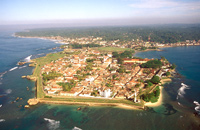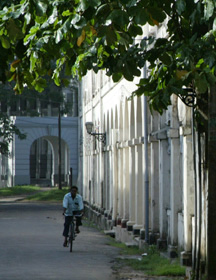
| Home |
| Where is Fort Galle? |
| Galle City |
| Galle Fort |
| Travelling Around |
| Places to See |
| Best Places to Stay |
| Shopping |
| 2004 Tsunami |
| Galle, Sri Lanka Today |
| Useful Resources |
| Resources |
A Quick Look at Galle City
The ancient port city of Galle (pronounced much like hall and mall) is located in the southwestern tip of Sri Lanka, formerly known as Ceylon.
Sri Lanka, which some historians call "India's Teardrop" because of its odd pear shape and its proximity to the mainland of India, is an island republic in the Indian Ocean. It measures 270 miles from its northern-most point to its southern-most point and 140 miles from east to west at its widest part. The capital city of Sri Lanka, which is also its largest, is Colombo.
 In the 6th century, Sri Lanka was occupied by the Sinhalese people from India but they were eventually taken over by the Tamils, also from India, in the 13th century. Indian domination of Sri Lanka ended in the 16th century with the arrival of the Portuguese which marked the beginning of the European colonization of the island.
In the 6th century, Sri Lanka was occupied by the Sinhalese people from India but they were eventually taken over by the Tamils, also from India, in the 13th century. Indian domination of Sri Lanka ended in the 16th century with the arrival of the Portuguese which marked the beginning of the European colonization of the island.
The city of Galle is some 115 kms south of Colombo and 18 kms south of Hikkaduwa, a popular beach resort also located in Sri Lanka. The city, which was formerly named Gimhathiththa, was said to have been given its name by the Portuguese when a cock (gallus in Portuguese) started crowing upon their arrival on the island. Most believe though that Galle's name is derived from gala, the Sinhala term for rock since the Galle harbor is strewn with rocks both above and below the waters.
During its period of colonization by the Portuguese and Dutch, Galle became the country's main port and the center of trade and commerce among Persians, Arabians, Greeks, Romans, Malays and Indians. As a port city, Galle's history goes as far back as the time of the biblical King Solomon. In fact, there are those who claim that Galle is the ancient biblical city of Tarshish whose seaports were witness to King Solomon's trade activities and from where this wise king obtained various gemstones, spices and scented woods. There is no historical data, however, to substantiate this claim.
 The Galle Fort was erected at the time of the Portuguese for the primary purpose of protecting the city from invading Tamils. In 1640, the Dutch, following a long protracted struggle, succeeded in wresting Galle and the rest of Sri Lanka away from Portuguese hold to establish a colonial rule that lasted for almost 150 years. During the time of the Dutch, Galle Fort was further strengthened and fortified and was slowly transformed into the romantic walled city that it is known today. For it's part, the ancient port city of Galle continued to prosper and bring in wealth as the island's main port.
The Galle Fort was erected at the time of the Portuguese for the primary purpose of protecting the city from invading Tamils. In 1640, the Dutch, following a long protracted struggle, succeeded in wresting Galle and the rest of Sri Lanka away from Portuguese hold to establish a colonial rule that lasted for almost 150 years. During the time of the Dutch, Galle Fort was further strengthened and fortified and was slowly transformed into the romantic walled city that it is known today. For it's part, the ancient port city of Galle continued to prosper and bring in wealth as the island's main port.
When the British took over Galle from the Dutch in 1796, they did very little to alter or eradicate any of the Dutch structures or influences already established. In fact, to this day, much of what visitors see of the Galle Fort is a reflection of the way Galle Fort was during the time of the Dutch.
One possible reason Galle was able to preserve much of its Dutch influences could be that, under British rule, the city was no longer as busy as it was during the time of the Portuguese and the Dutch. The reason for this was the development of the Colombo harbor as the island's major port in the 19th century replacing Galle.
British rule lasted until 1947 when Sri Lanka declared its independence from Britain. Although free of all European domination, the imprint of the years of colonization has stayed on the island and continues to give Sri Lanka the unique blend of Asian and European character the island continues to carry to this day.